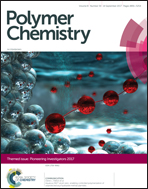Thermosensitive spontaneous gradient copolymers with block- and gradient-like features†
Abstract
Reversible addition–fragmentation chain transfer (RAFT) copolymerization was used to prepare copolymers of N-isopropyl acrylamide (NIPAM) and vinyl acetate (VAc) with mole fractions of NIPAM ranging from 0.1 to 0.6 and targeted degrees of polymerization of 100 and 250. The measured kinetic parameters and obtained experimental results revealed that this copolymerization system leads to a “one pot” synthesis of amphiphilic gradient copolymers, which have thermoresponsive and self-assembly characteristics resembling those of the analogous block copolymers but with some intriguing differences. Their self-assembly behavior in water suggests the formation of dynamic aggregates which respond rapidly to changes in solubility as revealed by 1H NMR spectroscopy, in contrast to the kinetically frozen aggregates formed by block copolymers. Furthermore, despite their block-like composition profiles, these copolymers display a single and broad glass transition, as is typically found in linear gradient copolymers. The synthetic approach presented in this contribution could readily be adapted to other comonomer systems to provide an accessible and economic alternative to the conventional multi-step preparation of block copolymers.

- This article is part of the themed collection: Pioneering Investigators


 Please wait while we load your content...
Please wait while we load your content...